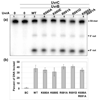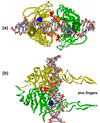Cooperative damage recognition by UvrA and UvrB: identification of UvrA residues that mediate DNA binding
- PMID: 18248777
- PMCID: PMC2396233
- DOI: 10.1016/j.dnarep.2007.11.013
Cooperative damage recognition by UvrA and UvrB: identification of UvrA residues that mediate DNA binding
Abstract
Nucleotide excision repair (NER) is responsible for the recognition and removal of numerous structurally unrelated DNA lesions. In prokaryotes, the proteins UvrA, UvrB and UvrC orchestrate the recognition and excision of aberrant lesions from DNA. Despite the progress we have made in understanding the NER pathway, it remains unclear how the UvrA dimer interacts with DNA to facilitate DNA damage recognition. The purpose of this study was to define amino acid residues in UvrA that provide binding energy to DNA. Based on conservation among approximately 300 UvrA sequences and 3D-modeling, two positively charged residues, Lys680 and Arg691, were predicted to be important for DNA binding. Mutagenesis and biochemical analysis of Bacillus caldontenax UvrA variant proteins containing site directed mutations at these residues demonstrate that Lys680 and Arg691 make a significant contribution toward the DNA binding affinity of UvrA. Replacing these side chains with alanine or negatively charged residues decreased UvrA binding 3-37-fold. Survival studies indicated that these mutant proteins complemented a WP2 uvrA(-) strain of bacteria 10-100% of WT UvrA levels. Further analysis by DNase I footprinting of the double UvrA mutant revealed that the UvrA DNA binding defects caused a slower rate of transfer of DNA to UvrB. Consequently, the mutants initiated the oligonucleotide incision assay nearly as well as WT UvrA thus explaining the observed mild phenotype in the survival assay. Based on our findings we propose a model of how UvrA binds to DNA.
Figures









References
-
- Croteau DL, Dellavecchia MJ, Skorvaga M, Van Houten B. Damage recognition by the bacterial nucleotide excision repair machinery. In: Wolfram S, Kow YW, Doetsch PW, editors. DNA Damage Recognition. Boca Raton, FL: Taylor & Francis; 2005. pp. 111–138.
-
- Van Houten B, Croteau DL, DellaVecchia MJ, Wang H, Kisker C. 'Close-fitting sleeves': DNA damage recognition by the UvrABC nuclease system. Mutat Res. 2005;577:92–117. - PubMed
-
- Truglio JJ, Croteau DL, Van Houten B, Kisker C. Prokaryotic Nucleotide Excision Repair: The UvrABC System. Chem Rev. 2006;106:233–252. - PubMed
-
- Moolenaar GF, Schut M, Goosen N. Binding of the UvrB dimer to non-damaged and damaged DNA: residues Y92 and Y93 influence the stability of both subunits. DNA Repair (Amst) 2005;4:699–713. - PubMed
-
- Orren DK, Sancar A. Formation and enzymatic properties of the UvrB.DNA complex. J Biol Chem. 1990;265:15796–15803. - PubMed
Publication types
MeSH terms
Substances
Grants and funding
LinkOut - more resources
Full Text Sources

